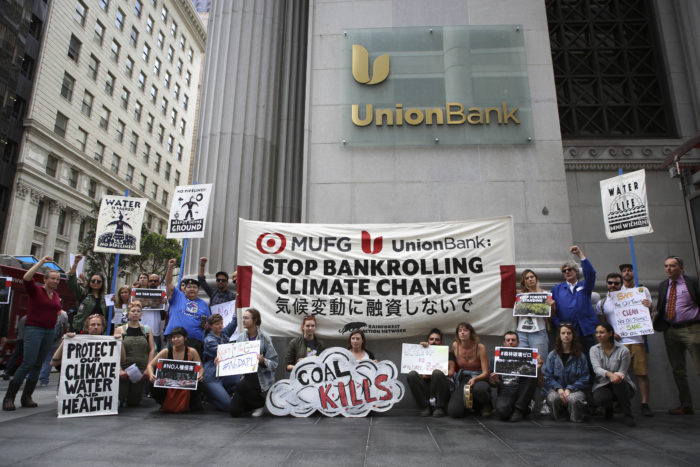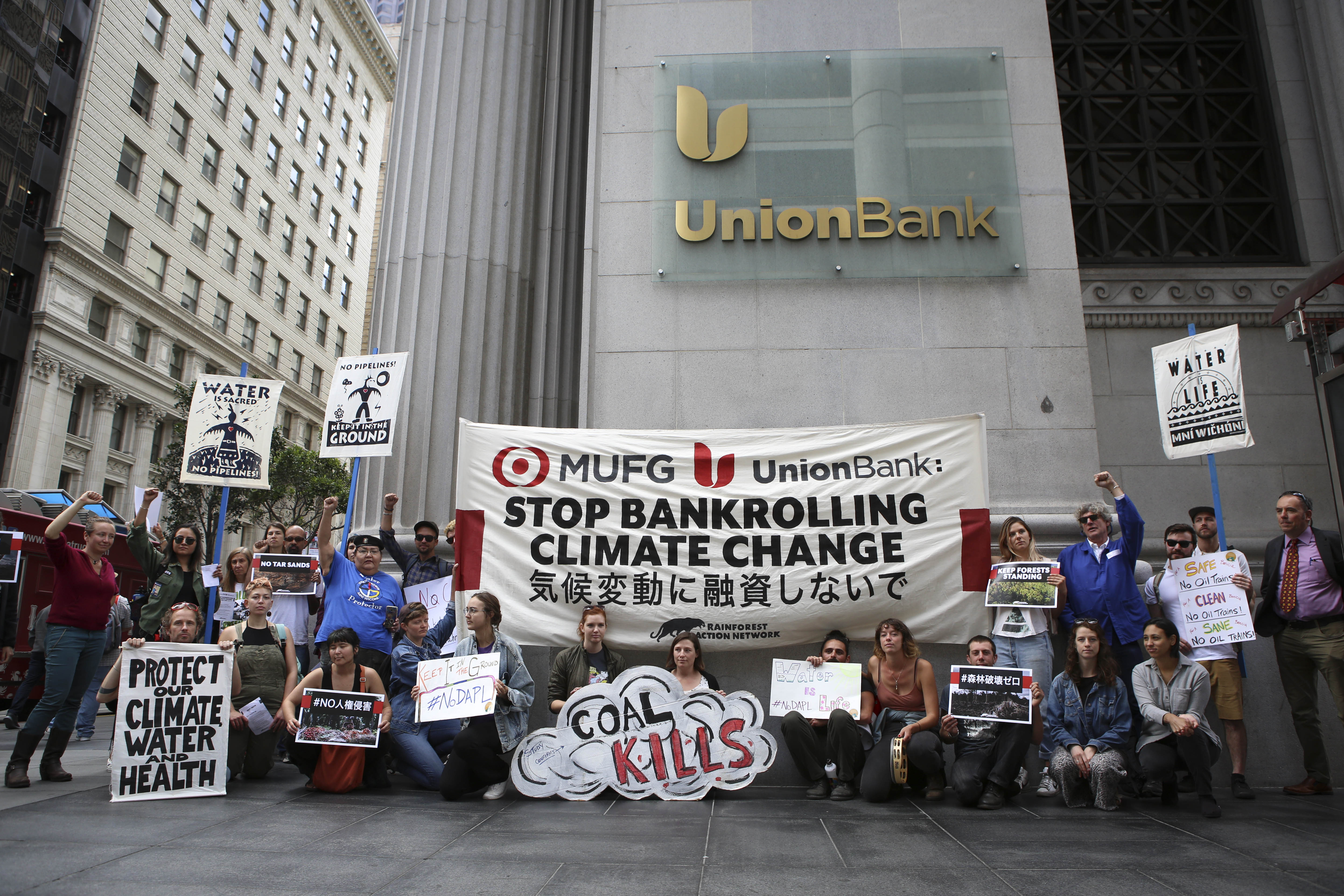This case study was written by Hana Heineken (RAN), Kimiko Hirata (KikoNet), Bernadette Maheandiran (Market Forces) and Shin Furuno (350.org Japan) for our latest bank report card, Banking on Climate Change: Fossil Fuel Finance Report Card 2019.
Japan’s three largest banks, MUFG, Mizuho, and SMBC Group, are fueling a coal power boom in Japan and abroad. In the remote countryside of southern Japan, a 1.2-gigawatt (GW) coal-fired power plant known as Nishioki No Yama is being developed by J-POWER, Japan’s largest coal plant developer and a major recipient of financing from all three banks.1 It is estimated that this plant will emit 7.9 million tons of CO2 once completed, and it is only one among 50 new coal power projects in Japan that have been planned since 2012, including three plants in Tokyo Bay.2 While five projects comprising six units have recently been cancelled or switched to a different fuel source, 15 GW of coal-fired power capacity remain in the pipeline, 6.4 GW of which are not yet under construction.3 If all of these projects are completed, Japan will be more dependent on coal than renewables.4 Most of these domestic coal power projects are being financed by Japan’s three megabanks.5
MUFG, Mizuho, and SMBC Group also provide significant funding to coal power projects overseas, notably in Indonesia and Vietnam. All three banks are expected to fund Van Phong 1, a 1.3 GW supercritical coal plant in Vietnam sponsored by Sumitomo Corporation, which is expected to produce SO2, NOx, and particulate matter emissions at least five times more than most new coal projects in Japan.6 This plant is planned in addition to the controversial Nghi Son 2, a 1.2 GW coal power plant in Vietnam that is being constructed by Korea Electric Power Company (KEPCO) and Marubeni.7 The banks’ funding of this project is currently the subject of an OECD complaint.8 Standard Chartered appears to have walked away from Nghi Son 2 prior to financial close due to the carbon intensity of the project.9

As these cases illustrate, MUFG, Mizuho, and SMBC Group are facilitating the expansion of coal power globally, with no signs of the rapid phase-out that’s needed in order to achieve the Paris Agreement goals. This report card found that between 2016 and 2018, these three banks provided a combined $7.4 billion in loans and underwriting services to 30 top global coal power producers, including J-POWER and KEPCO. Research published in December 201810 also found that Mizuho, MUFG, and SMBC Group were the first-, second-, and fourth-largest global lenders to the top 120 international coal developers between 2016 and September 2018. Mizuho has been the leading lender and underwriter to 20 companies rapidly developing coal power in Japan, providing nearly twice as much financing as MUFG or SMBC Group.11
These three banks’ financing of coal is in stark contrast to their peers and their own endorsement of the TCFD.12 While the banks adopted new coal power policies in the last year, they lack any meaningful safeguards against financing climate catastrophe.13 With the growing impacts of climate change, including in Japan — where heavy rainfall, landslides, and extreme heat in 2018 killed approximately 300 people — the banks’ financing of coal power expansion constitutes a significant reputational and financial risk, including a material risk of stranded assets given the drastic decline in the cost of renewables and storage technology.14 The banks need to adopt a rapid transition plan away from coal and carbon-intensive sectors more broadly, and their largest investors — BlackRock and the Government Pension Investment Fund of Japan — should ensure this happens as quickly as possible.15
- “Notification, Sending, Candidate Listing and Information Briefing on “Environmental Impact Assessment Method” Pertaining to the Plan for the Establishment of the Nishi-Ku Naoyama Power Station (Tentative Name),” J-Power, 10 November 2013; Heffa Schuecking et al., “The 2018 Coal Plant Pipeline – A Global Tour,” urgewald e.V., October 2018, p. 25; Bloomberg Finance L.P. and the data researched for this report, January 2019.
- “Opinion on “Preparedness for Environmental Impact Assessment Plan for Nishi – kawa Nozan Power Station (Tentative Name) Newly Established,” Kiko Network, 9 November 2018; “Japan Coal Plant Tracker,” Kiko Network, accessed January 2019.
- “Move from Coal to Gas in Sodegaura a Half-hearted Response to Global Energy Trends,” Greenpeace Japan, 31 January 2018; “Japan Coal Plant Tracker,” Kiko Network, accessed January 2019.
- Eri Sugiura and Akane Okutsu, “Power Struggles,” Nikkei Asian Review, 26 November – 2 December 2018.
- “Japan Coal Plant Tracker,” Kiko Network, accessed January 2019; Ward Warmerdam and Melina van Scharrenburg, “Energy Finance in Japan 2018,” 350.org Japan, 10 September 2018.
- “Japanese Banks: Respect Your Commitments: Don’t Fund Dirty Coal Projects Like Van Phong 1,” Market Forces, 6 February 2019; Lauri Myllyvirta, Lead Analyst, Greenpeace Global Air Pollution Unit, based on: EIA, “Projects for Which JBIC Has Already Acquired Environmental Impact Assessment (EIA),” Japan Bank for International Cooperation, accessed February 2019.
- “Nghi Son 2 (2 x 600MW),” Market Forces, 4 October 2018.
- “Market Forces Files Complaint Over Japanese Banks’ Coal Lending Breach of OECD Guidelines,” Market Forces, 18 September 2018.
- “Nghi Son 2 (2 x 600MW),” Market Forces, 4 October 2018.
- Note that the lending aggregated in the research cited here does not adjust transaction values down by the percentage of each company’s business in coal power, in contrast to the adjusted numbers aggregated in the fossil fuel finance report card. “COP24: New Research Reveals the Banks and Investors Financing the Expansion of the Global Coal Plant Fleet,” urgewald e.V. and BankTrack, 5 December 2015.
- Ward Warmerdam and Melina van Scharrenburg, “Energy Finance in Japan 2018,” 350.org Japan, 10 September 2018.
- “TCFD Supporters,” TCFD, accessed January 2019.
- “‘A Small Step Forward, But Not Nearly Enough’: Environmental NGOs Respond to Release of New MUFG Environmental, Social and Human Rights Policy,” 350.org Japan, JACSES, Rainforest Action Network, Kiko Network, and FoE Japan, 25 May 2018; “‘A Small Step Forward on Climate Change Risk Management, But Bolder Action Required’: Environmental NGOs Respond to Release of New Mizuho Financial Group Financing Policy,” 350.org Japan et al., 15 June 2018; “Environmental NGOs Evaluate SMBC’s New Sector Policies on Coal-Fired Power, Palm Oil and Deforestation: ‘A Policy Showing Little Progress With a Concerning Loophole That Does Not Align With the Paris Agreement’,” 350.org Japan et al., 21 June 2018.
- Bob Berwyn, “This Summer’s Heat Waves Could Be the Strongest Climate Signal Yet,” InsideClimate News, 28 July 2018; Hiroko Tabuchi, “Tokyo Is Preparing for Floods ‘Beyond Anything We’ve Seen’,” The New York Times, 6 October 2017; “Paola Yanguas Parra et al., Science Based Coal Phase-Out Timeline for Japan: Implications for Policymakers and Investors,” Climate Analytics, May 2018.
- Bloomberg Finance L.P., accessed December 2018.
